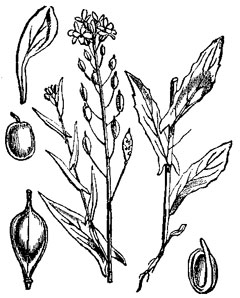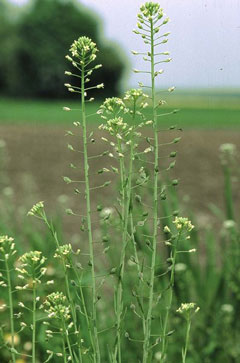 |
|
http://commons.wikimedia.org/wiki/File:Nsr-slika-181.png |
 |
| http://commons.wikimedia.org/wiki/User:Fornax |
Translate this page:
Summary
Physical Characteristics

 Camelina sativa is a ANNUAL growing to 0.6 m (2ft) by 0.1 m (0ft 4in).
Camelina sativa is a ANNUAL growing to 0.6 m (2ft) by 0.1 m (0ft 4in).
See above for USDA hardiness. It is hardy to UK zone 7. It is in flower from June to July, and the seeds ripen in August. The species is hermaphrodite (has both male and female organs).
Suitable for: light (sandy), medium (loamy) and heavy (clay) soils, prefers well-drained soil and can grow in nutritionally poor soil. Suitable pH: mildly acid, neutral and basic (mildly alkaline) soils. It can grow in semi-shade (light woodland) or no shade. It prefers dry or moist soil.
UK Hardiness Map
US Hardiness Map
Synonyms
Myagrum sativum.
Plant Habitats
Cultivated Beds;
Edible Uses
Edible Parts: Oil Oil
Edible Uses: Oil Oil
An edible oil is obtained from the seed[2, 17, 105, 177, 183].
References More on Edible Uses
Medicinal Uses
Plants For A Future can not take any responsibility for any adverse effects from the use of plants. Always seek advice from a professional before using a plant medicinally.
None known
References More on Medicinal Uses
The Bookshop: Edible Plant Books
Our Latest books on Perennial Plants For Food Forests and Permaculture Gardens in paperback or digital formats.

Edible Tropical Plants
Food Forest Plants for Hotter Conditions: 250+ Plants For Tropical Food Forests & Permaculture Gardens.
More

Edible Temperate Plants
Plants for Your Food Forest: 500 Plants for Temperate Food Forests & Permaculture Gardens.
More

More Books
PFAF have eight books available in paperback and digital formats. Browse the shop for more information.
Shop Now
Other Uses
Broom Fibre Oil Oil
An oil from the seed is used as a luminant and as an emollient for softening the skin[100]. A fibre is obtained from the stems[2, 200]. The stems are used for making brooms[2].
Special Uses
References More on Other Uses
Cultivation details
An easily grown plant, succeeding in most soils and preferring a sunny position[K]. It does well on poor land[115]. Plants can self-sow when well-sited[K]. 'Gold of Pleasure' is occasionally cultivated for the oil in its seed[17, 171]. This species is a bad companion plant, depressing the growth of nearby plants[18]. It has become a noxious weed of cultivated fields in some of the areas into which it has been introduced[2].
References Carbon Farming Information and Carbon Sequestration Information
Temperature Converter
Type a value in the Celsius field to convert the value to Fahrenheit:
Fahrenheit:
The PFAF Bookshop
Plants For A Future have a number of books available in paperback and digital form. Book titles include Edible Plants, Edible Perennials, Edible Trees,Edible Shrubs, Woodland Gardening, and Temperate Food Forest Plants. Our new book is Food Forest Plants For Hotter Conditions (Tropical and Sub-Tropical).
Shop Now
Plant Propagation
Seed - sow mid spring in situ.
Other Names
If available other names are mentioned here
Native Range
TEMPERATE ASIA: Turkey (northwest), Russian Federation-Ciscaucasia (Ciscaucasia), Armenia, Russian Federation (Dagestan), Kazakhstan, Tajikistan, Turkmenistan, Mongolia TROPICAL ASIA: India (Jammu and Kashmir), Pakistan (north) EUROPE: Denmark, United Kingdom, Sweden, Austria, Belgium, Switzerland, Germany, Hungary, Netherlands, Russian Federation (European part), Moldova, Ukraine (Krym), Albania, Bulgaria, Bosnia and Herzegovina, Greece (incl. Crete), Croatia, Italy (incl. Sardinia, Sicily), North Macedonia, Montenegro, Romania, Serbia, Slovenia, Spain (incl. Baleares), France (incl. Corsica)
Weed Potential
Right plant wrong place. We are currently updating this section.
Please note that a plant may be invasive in one area but may not in your area so it's worth checking.
Conservation Status
IUCN Red List of Threatened Plants Status :

Growth: S = slow M = medium F = fast. Soil: L = light (sandy) M = medium H = heavy (clay). pH: A = acid N = neutral B = basic (alkaline). Shade: F = full shade S = semi-shade N = no shade. Moisture: D = dry M = Moist We = wet Wa = water.
Now available:
Food Forest Plants for Mediterranean Conditions
350+ Perennial Plants For Mediterranean and Drier Food Forests and Permaculture Gardens.
[Paperback and eBook]
This is the third in Plants For A Future's series of plant guides for food forests tailored to
specific climate zones. Following volumes on temperate and tropical ecosystems, this book focuses
on species suited to Mediterranean conditions—regions with hot, dry summers and cool, wet winters,
often facing the added challenge of climate change.
Read More
Expert comment
Author
(L.)Crantz.
Botanical References
200
Links / References
For a list of references used on this page please go here
Readers comment